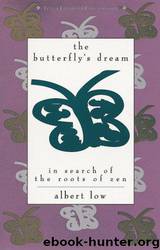The Butterfly's Dream: In Search of the Roots of Zen by Albert Low

Author:Albert Low
Language: eng
Format: mobi
Published: 2014-12-21T05:00:00+00:00
1 Mircea Eliade, The Sacred and the Profane (New York: Harvest Books, 1957), p. 22.
2 Ibid., p. 27
The world center is not a geographical center but a dynamic center, and, as we have said, there can only be one such center. If there were more than one a terrible conflict would arise over which was the real one. This is quite evident when we consider human societies and groups. It is axiomatic a group can have only one leader; for example, only one president of a company. A leader is the center, the source of initiative, and at the center of the lines of communication of the group. The role of the leader is most often implicit during times of no apparent conflict, but during times of stress and confusion this role becomes very active. Even in space vehicles, which might have only two crew members, one is always appointed the leader. Revolts happen when, in addition to an existing leader, another arises to challenge him or her. When this happens and until the dispute is settled, there will be confusion and even chaos in the group.
It is evident, then, the loss of the sacred pole would be a terrible tragedy to the Achilpa tribe, as it would open the members to an infinite number of potential candidates to be the center, each opposing the others. This would generate anxiety and panic. Indeed, Eliade said, "For the pole to be broken denotes catastrophe; it is like 'the end of the world,' reversion to chaos."4 Once, according to some anthropologists who observed this tribe, when the pole was broken, the entire clan was in consternation; "They wandered about aimlessly for a time and finally lay down on the earth together and waited for death to overtake them."5
In case someone should think this is simply an aberration of a single primitive people, we must remember that throughout history, and in all kinds of societies, it has been the practice to carry a banner into battle. This banner is but an ornate pole. If it were captured by the enemy, the army would collapse, and panic and chaos follow. To carry the banner into battle was both an honor and a great danger. It was an honor because it meant one's valor had been recognized; it would be a great danger because the one carrying the banner would be a prime target. Even in our sophisticated and cynical culture the flag is still sacred to many people for whom it is the center of power of the group.
Furthermore, people who have become lost in a forest have panicked and died of fear. They were lost because all trees looked alike to them and none had special value. Therefore none could represent the center.
Download
This site does not store any files on its server. We only index and link to content provided by other sites. Please contact the content providers to delete copyright contents if any and email us, we'll remove relevant links or contents immediately.
| Anthropology | Archaeology |
| Philosophy | Politics & Government |
| Social Sciences | Sociology |
| Women's Studies |
The remains of the day by Kazuo Ishiguro(8413)
Tools of Titans by Timothy Ferriss(7828)
Giovanni's Room by James Baldwin(6822)
The Black Swan by Nassim Nicholas Taleb(6784)
Inner Engineering: A Yogi's Guide to Joy by Sadhguru(6449)
The Way of Zen by Alan W. Watts(6292)
Asking the Right Questions: A Guide to Critical Thinking by M. Neil Browne & Stuart M. Keeley(5363)
The Power of Now: A Guide to Spiritual Enlightenment by Eckhart Tolle(5347)
The Six Wives Of Henry VIII (WOMEN IN HISTORY) by Fraser Antonia(5242)
Astrophysics for People in a Hurry by Neil DeGrasse Tyson(5004)
12 Rules for Life by Jordan B. Peterson(4166)
Housekeeping by Marilynne Robinson(4071)
The Ethical Slut by Janet W. Hardy(4042)
Skin in the Game by Nassim Nicholas Taleb(3978)
Double Down (Diary of a Wimpy Kid Book 11) by Jeff Kinney(3937)
Ikigai by Héctor García & Francesc Miralles(3903)
The Art of Happiness by The Dalai Lama(3851)
Skin in the Game: Hidden Asymmetries in Daily Life by Nassim Nicholas Taleb(3736)
Walking by Henry David Thoreau(3693)
